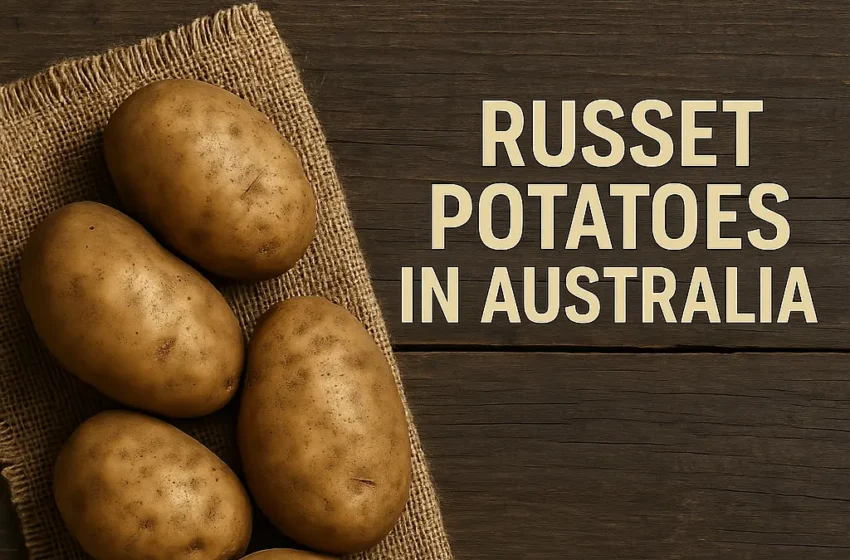Kyle Turner: The Rabbitohs legend who never forgot his roots

How to use russet potatoes in Australia
Russet potatoes are a beloved variety known for their rough, brown skin and soft, fluffy interior—ideal for baking, mashing, or turning into crispy homemade chips. While they are a staple in the American kitchen, russet potatoes in Australia are not as commonly found as varieties like Sebago or Dutch Cream. When it comes to high-starch potatoes in Australia, russets are often the go-to choice for specific recipes that require a fluffy finish. In this article, we’ll explore russet potatoes in Australia—how to grow them, how to cook with them, and why chefs and foodies seek them out.
What are russet potatoes?
Russet potatoes are a popular potato variety in the United States, easily recognised by their thick, brown skin and starchy, dry flesh. They are large, oblong potatoes. They are excellent for:
- Baking (those crispy jackets, fluffy jackets)
- Mashing (feels light and creamy)
- Chips (they fry perfectly golden and crisp)
- Hash browns and wedges
Their high starch content and low moisture content make russet potatoes the perfect variety of potato for recipes that require a fluffy interior or crisp exterior.
Do you grow russet potatoes in Australia?
Russet potatoes are not commonly cultivated in Australia, as the majority of Aussie farms are focused on some regional varieties, including:
- Sebago – A good all-purpose potato, suitable for boiling and roasting
- Dutch Cream – Known for a rich, buttery texture, perfect for mashing
- Kennebec – Considered one of the best potatoes for chips
- Desiree – With pink skin and versatile uses, from boiling to baking
While Australia’s climate supports potato cultivation, russets are primarily bred and harvested for the North American market. Some specialized growers and suppliers may sell russets in small quantities, but that is in metropolitan areas or more specialized grocers or organic food networks.
Where to find russet potatoes in Australia
Even though they are not as ubiquitous as the Sebago or Dutch Cream, russet potatoes can be sourced through:
- Specialty Grocers in larger cities like Sydney, Melbourne, or Brisbane
- Online produce markets and organic delivery services
- International food stores that stock American products
- Bulk wholesale suppliers for restaurants and chefs
They’re not typically stocked at Woolworths or Coles, so if you’re after russets, it’s best to check with specialty outlets or order online.
Why chefs and foodies love russet potatoes
While russet potatoes are relatively rare in Australia and not commonly used, they are still a popular ingredient often sought after by chefs looking for a specific ingredient for a recipe:
- They make the fluffiest baked potatoes
- They get a gorgeous golden crisp when deep-fried
- They soak up flavours beautifully in mashed and seasoned dishes
- They’re ideal for American-style recipes like loaded baked potatoes or fries
If you replicate a dish that calls for russet potatoes, you will detect a change in the texture when using other varieties; with the right adjustments, local spuds can be just as good.
Best Alternatives for Russet Potatoes in Australia
If you don’t have access to russet potatoes, there is no need to panic. Depending on what you are cooking, some excellent Australian varieties are listed below:
- For baking: Kennebec or Sebago
- For Mashing: Dutch Cream or Desiree
- For Chips/Wedges: Kennebec or Coliban are good options
- For Hash Browns: You can go with Kestrel or Sebago
One rule of thumb would be to make sure you are using the right cooking technique for the right type of potato. Waxy potatoes won’t give you the same fluffy finish as a russet, but depending on how much butter and seasoning you add, they can still be satisfying.
How to use russet potatoes in Aussie recipes
Regardless of how we might find russets labeled in our Australian shops, we have found that russets can be a wonderful addition to certain dishes. Here are a few suggestions:
- Baked potatoes: Russets have the best skin that crisps up nicely, while the inside turns light and fluffy. Top it with sour cream, cheese, or chives.
- Chips & wedge: For homemade chips, russets cannot be beaten. Chimps made with russets—thick or thin cut—are golden and crunchy.
- Mash: Because russets are so high in starch, they yield the smoothest, creamiest mashed potatoes without being gummy.
- Gnocchi: Since russets are dry and fluffy, they require less flour, and any gnocchi made from russets will yield the best tender gnocchi.
Are russet potatoes healthier than others?
The nutritional profile of russet potatoes closely resembles that of other white potatoes, such as:
- Vitamin C
- Potassium
- Dietary fibre
- Antioxidants (especially in the skin)
They have a higher glycaemic index (due to their high starch content) than waxy varieties, but that doesn’t mean they are “bad” for you – just keep that in mind if you are managing your blood sugar levels.
Final thoughts
If you’re a foodie, chef, or an adventurous home cook, russet potatoes in Australia are worth trying at least once, especially if you love baked spuds and fries. While they are not common in Australian agriculture, russet potatoes Australia are available, but may take a little effort for you to source through specialty grocers, or even online.
Each Aussie state may have its own stockists, so always check that what you’re buying is truly a russet. Either way, for everyday eating, our variety of local spuds, Sebago, Dutch Cream, or our wooden cousins, the Kennebec, are all great and are readily available. If you are preparing for your Sunday roast or want to give loaded fries, knowing your spuds will elevate your kitchen’s skills.

